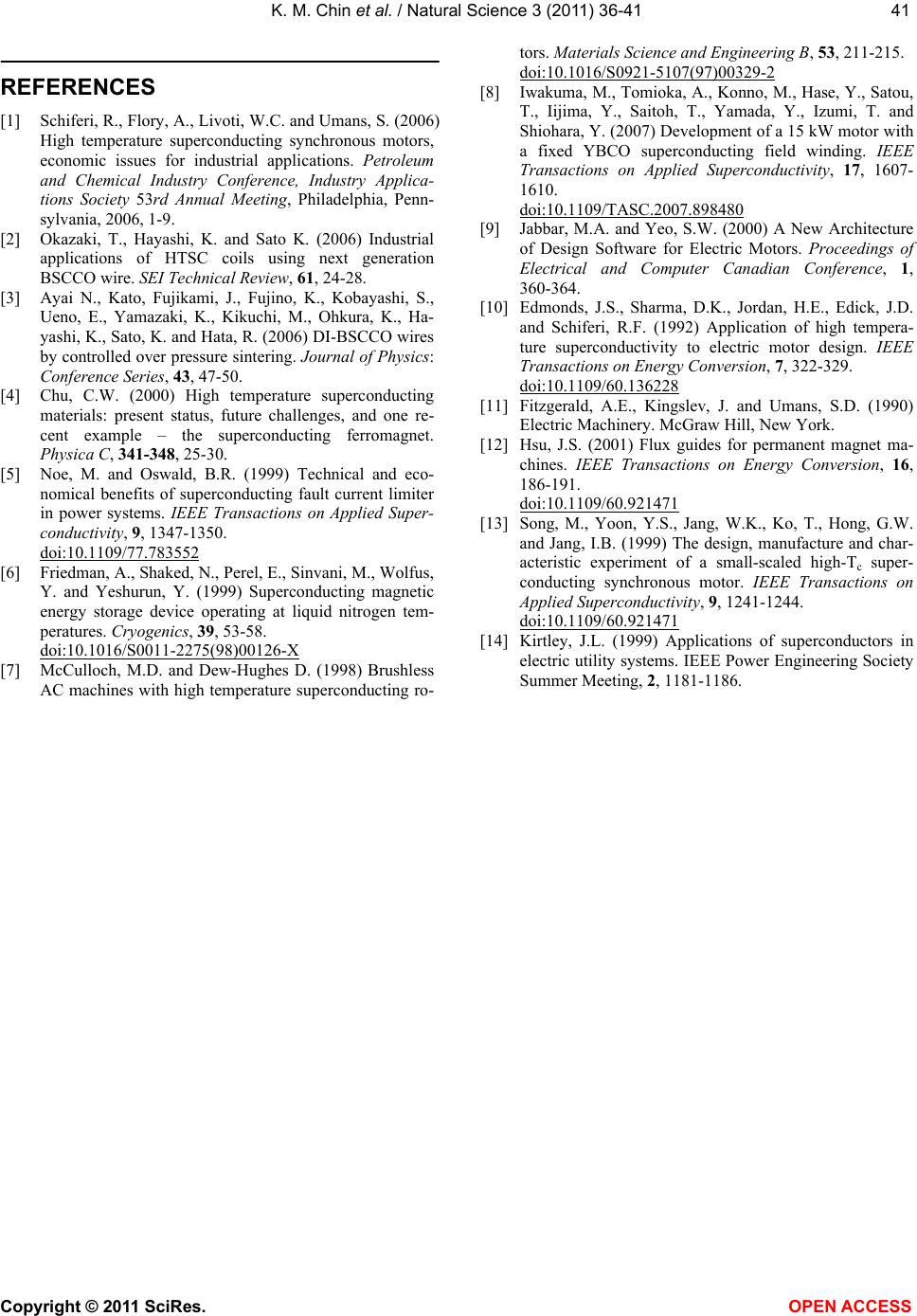
K. M. Chin et al. / Natural Science 3 (2011) 36-41
Copyright © 2011 SciRes. OPEN ACCESS
4141
REFERENCES
[1] Schiferi, R., Flory, A., Livoti, W.C. and Umans, S. (2006)
High temperature superconducting synchronous motors,
economic issues for industrial applications. Petroleum
and Chemical Industry Conference, Industry Applica-
tions Society 53rd Annual Meeting, Philadelphia, Penn-
sylvania, 2006, 1-9.
[2] Okazaki, T., Hayashi, K. and Sato K. (2006) Industrial
applications of HTSC coils using next generation
BSCCO wire. SEI Technical Review, 61, 24-28.
[3] Ayai N., Kato, Fujikami, J., Fujino, K., Kobayashi, S.,
Ueno, E., Yamazaki, K., Kikuchi, M., Ohkura, K., Ha-
yashi, K., Sato, K. and Hata, R. (2006) DI-BSCCO wires
by controlled over pressure sintering. Journal of Physics:
Conference Series, 43, 47-50.
[4] Chu, C.W. (2000) High temperature superconducting
materials: present status, future challenges, and one re-
cent example – the superconducting ferromagnet.
Physica C, 341-348, 25-30.
[5] Noe, M. and Oswald, B.R. (1999) Technical and eco-
nomical benefits of superconducting fault current limiter
in power systems. IEEE Transactions on Applied Super-
conductivity, 9, 1347-1350.
doi:10.1109/77.783552
[6] Friedman, A., Shaked, N., Perel, E., Sinvani, M., Wolfus,
Y. and Yeshurun, Y. (1999) Superconducting magnetic
energy storage device operating at liquid nitrogen tem-
peratures. Cryogenics, 39, 53-58.
doi:10.1016/S0011-2275(98)00126-X
[7] McCulloch, M.D. and Dew-Hughes D. (1998) Brushless
AC machines with high temperature superconducting ro-
tors. Materials Science and Engineering B, 53, 211-215.
doi:10.1016/S0921-5107(97)00329-2
[8] Iwakuma, M., Tomioka, A., Konno, M., Hase, Y., Satou,
T., Iijima, Y., Saitoh, T., Yamada, Y., Izumi, T. and
Shiohara, Y. (2007) Development of a 15 kW motor with
a fixed YBCO superconducting field winding. IEEE
Transactions on Applied Superconductivity, 17, 1607-
1610.
doi:10.1109/TASC.2007.898480
[9] Jabbar, M.A. and Yeo, S.W. (2000) A New Architecture
of Design Software for Electric Motors. Proceedings of
Electrical and Computer Canadian Conference, 1,
360-364.
[10] Edmonds, J.S., Sharma, D.K., Jordan, H.E., Edick, J.D.
and Schiferi, R.F. (1992) Application of high tempera-
ture superconductivity to electric motor design. IEEE
Transactions on Energy Conversion, 7, 322-329.
doi:10.1109/60.136228
[11] Fitzgerald, A.E., Kingslev, J. and Umans, S.D. (1990)
Electric Machinery. McGraw Hill, New York.
[12] Hsu, J.S. (2001) Flux guides for permanent magnet ma-
chines. IEEE Transactions on Energy Conversion, 16,
186-191.
doi:10.1109/60.921471
[13] Song, M., Yoon, Y.S., Jang, W.K., Ko, T., Hong, G.W.
and Jang, I.B. (1999) The design, manufacture and char-
acteristic experiment of a small-scaled high-Tc super-
conducting synchronous motor. IEEE Transactions on
Applied Superconductivity, 9, 1241-1244.
doi:10.1109/60.921471
[14] Kirtley, J.L. (1999) Applications of superconductors in
electric utility systems. IEEE Power Engineering Society
Summer Meeting, 2, 1181-1186.